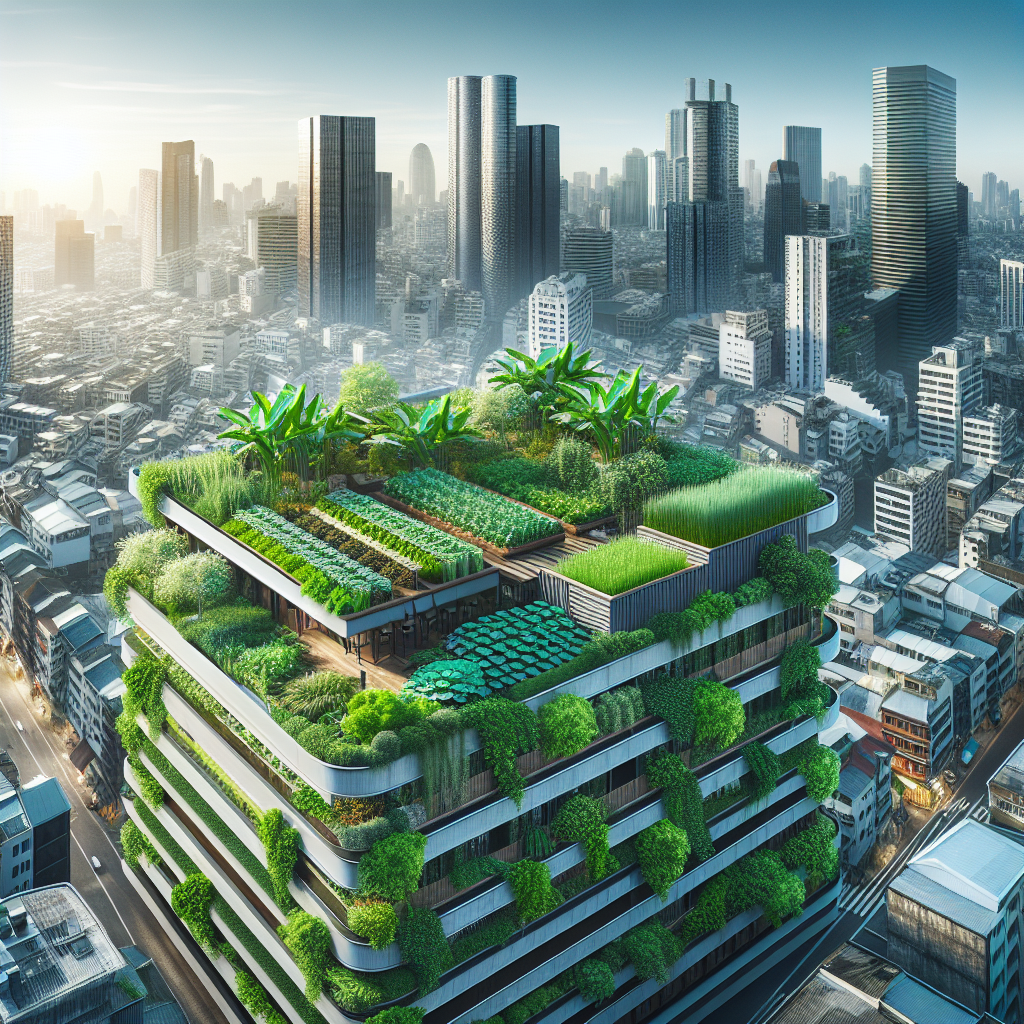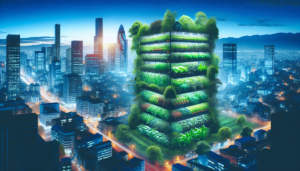
In today’s rapidly urbanizing world, the concept of urban farming is gaining increasing popularity as a means to promote sustainable practices and enhance the quality of urban landscapes. As cities become more crowded and space becomes a precious commodity, the integration of agriculture within urban environments is proving to have a multitude of benefits. From improving air quality to reducing urban heat island effects, urban farming not only contributes to food production but also plays a vital role in promoting green architecture and urban design. By harnessing the power of nature and incorporating it into the fabric of our cities, we can create a harmonious blend of nature and concrete, fostering healthier and more sustainable urban environments for all.
Urban Farming and Green Architecture
Urban farming refers to the practice of growing food and cultivating crops within urban areas. It involves transforming rooftops, balconies, vacant lots, and other open spaces into productive gardens or farms. On the other hand, green architecture, also known as sustainable or eco-friendly architecture, focuses on designing buildings and structures that have minimal negative impacts on the environment. It involves incorporating sustainable materials, energy-efficient systems, and green spaces into architectural designs.
The relationship between urban farming and green architecture is closely intertwined. Urban farming can significantly contribute to the principles and goals of green architecture and urban design. By integrating agriculture into urban areas, cities can become more sustainable, resilient, and livable. Let’s explore the benefits and challenges of urban farming in green architecture and urban design.
Benefits of Urban Farming in Green Architecture and Urban Design
Contribution to Sustainable Food Production
One of the key benefits of urban farming in green architecture is its contribution to sustainable food production. As cities continue to face challenges in ensuring food security, urban farming plays a crucial role in reducing the reliance on imported food and promoting local, organic, and fresh produce. By growing food within the city limits, urban farming reduces the carbon footprint associated with transportation and storage of food, while also providing opportunities for community engagement and education.
Improvement of Air Quality and Carbon Sequestration
Urban farming can also enhance air quality and contribute to carbon sequestration. Plants, including crops and trees, absorb carbon dioxide and release oxygen through photosynthesis. By integrating green spaces, such as rooftop gardens and vertical farms, into the built environment, urban farming helps reduce greenhouse gas emissions and mitigates the effects of climate change. Additionally, urban vegetation acts as natural air filters, capturing pollutants and improving overall air quality.
Reduction of Urban Heat Island Effect
Cities often experience elevated temperatures due to the urban heat island effect, which occurs when built surfaces like asphalt and concrete absorb heat and raise local temperatures. Urban farming can help mitigate this effect by providing shade, absorbing heat, and promoting evaporative cooling. Rooftop gardens, green roofs, and vertical farming systems create a layer of vegetation that helps regulate temperatures, reduce energy consumption for cooling, and create more comfortable microclimates in urban areas.
Enhancement of Biodiversity and Ecosystem Services
Integrating urban farming into green architecture and urban design can enhance biodiversity and support ecosystem services. As urban areas expand, natural habitats are often lost, leading to a decline in biodiversity. However, urban farming initiatives can create habitats for pollinators, birds, and other wildlife, fostering ecological diversity within cities. Furthermore, urban farms can provide ecosystem services such as soil erosion prevention, water filtration, and habitat creation for beneficial insects and birds.
Management of Stormwater and Water Conservation
Urban farming plays a critical role in stormwater management and water conservation. Through practices such as rainwater harvesting, permeable pavements, and green infrastructure, urban farms can reduce stormwater runoff and alleviate pressure on urban drainage systems. Additionally, efficient irrigation methods in urban farming, such as hydroponics and drip irrigation, can help conserve water resources by delivering water directly to the plants’ roots, minimizing water wastage.
Integration of Urban Farming in Green Architecture and Urban Design
To fully realize the benefits of urban farming in promoting green architecture and urban design, various strategies can be employed. Here are some common approaches for integrating urban farming into the built environment:
Rooftop Gardens and Green Roofs
Rooftop gardens and green roofs are excellent ways to incorporate urban farming into green architecture. By utilizing the empty space on top of buildings, these gardens allow for the cultivation of crops, herbs, and even small trees. The roofs act as insulation, reducing energy consumption and providing additional green spaces for recreation and relaxation. Rooftop gardens and green roofs also have the potential to capture rainwater, provide habitat for wildlife, and contribute to urban biodiversity.
Vertical Farming
Vertical farming is a revolutionary approach to urban agriculture that involves growing crops in vertically stacked layers or hydroponic systems. This method maximizes space utilization while minimizing land requirements. Vertical farms often utilize efficient lighting systems, automated irrigation, and nutrient delivery techniques to optimize plant growth. By integrating vertical farming into urban design, cities can create self-sufficient food production systems that are both sustainable and scalable.
Living Walls and Vertical Gardens
Living walls, also known as green walls or vertical gardens, are vertical structures covered with plants. These walls can be integrated into the facade of buildings, providing numerous benefits. Living walls not only enhance the aesthetic appeal of buildings but also improve air quality, reduce energy consumption, and mitigate the urban heat island effect. In urban farming, living walls can be designed to grow herbs, vegetables, or even edible flowers, creating a unique and functional green space.
Edible Landscaping and Permaculture
Edible landscaping combines food production with ornamental design principles, incorporating edible plants into traditional landscaping. By integrating fruit trees, berry bushes, and edible plants into public parks, streetscapes, and private gardens, cities can transform urban landscapes into productive and visually appealing spaces. Permaculture principles, such as companion planting, water conservation, and organic practices, can be applied to urban agriculture, creating resilient and sustainable food systems.
Hydroponics and Aquaponics
Hydroponics and aquaponics are soilless farming techniques that use nutrient-rich water to cultivate crops. Hydroponics involves growing plants in a nutrient solution, while aquaponics combines hydroponics with aquaculture, utilizing fish waste to nourish the plants. These systems can be implemented in indoor facilities or urban farms, providing year-round production and conserving water resources. Hydroponics and aquaponics offer high yields, faster growth rates, and efficient use of space, making them ideal for urban farming in limited areas.
Challenges and Considerations for Urban Farming in Green Architecture and Urban Design
While urban farming in green architecture offers numerous benefits, there are also several challenges and considerations that need to be addressed:
Space Limitations and Land Availability
Space limitations can pose challenges for urban farming initiatives. In densely populated cities, finding suitable land for agriculture can be difficult. However, creative solutions such as rooftop gardens, vertical farming, and repurposing underutilized spaces are effective ways to overcome limited land availability. By utilizing existing infrastructures and maximizing vertical space, urban farming can thrive even in densely built environments.
Infrastructure and Technology Requirements
Implementing urban farming in green architecture may require investments in infrastructure and technology. Adequate water supply, irrigation systems, lighting, and climate control systems are essential for successful urban farming. Additionally, technologies such as sensors, automation, and data analytics can optimize resource use and crop management. Investments in infrastructure and technology should be carefully planned and designed to ensure the long-term viability and efficiency of urban farming projects.
Maintenance and Management
Urban farming in green architecture requires ongoing maintenance and management, including soil fertility management, pest control, and crop rotation. Adequate resources, skilled labor, and community involvement are crucial for the successful operation of urban farms. Additionally, regular monitoring and evaluation should be conducted to assess the effectiveness of farming practices and make necessary adjustments. Proper maintenance and management ensure the productivity, health, and sustainability of urban farming projects.
Regulations and Zoning
Regulations and zoning play a vital role in promoting urban farming in green architecture. Cities need to establish clear guidelines and policies that support and incentivize urban farming initiatives. These policies should address issues such as land use, water rights, urban agriculture zoning, and building codes. By providing a supportive regulatory framework, cities can encourage the integration of urban farming into green architecture and urban design.
Community Engagement and Social Equity
Community engagement and social equity are fundamental aspects of urban farming in green architecture. It is essential to involve local communities in the planning, design, and implementation of urban farming projects. Engaging community members fosters a sense of ownership, pride, and responsibility, ensuring the long-term success and sustainability of urban farming initiatives. Furthermore, urban farming can create economic opportunities, improve access to fresh and healthy food, and promote social cohesion within communities.
Successful Examples of Urban Farming in Green Architecture and Urban Design
Several successful examples demonstrate the potential of urban farming in promoting green architecture and urban design. Let’s explore some notable projects:
The High Line, New York City
The High Line is an elevated linear park built on a historic freight rail line on Manhattan’s west side. This vibrant public space incorporates greenery, including native and adaptive plant species, and provides opportunities for urban farming. The High Line features a section dedicated to urban agriculture, where herbs, vegetables, and flowers are grown. This urban farming initiative not only adds visual interest and biodiversity but also brings the community together around food production and horticultural education.
The Ren Building, Singapore
The Ren Building, located in Singapore’s Punggol area, is a residential development designed with sustainability and urban farming in mind. The development features sky gardens, rooftop farms, and vertical greenery, integrating urban agriculture into the building’s design. Residents can participate in farming activities and harvest their own produce, fostering a sense of community and self-sufficiency. The Ren Building showcases the successful integration of urban farming into residential architecture, promoting sustainable urban living.
The Plant, Chicago
The Plant is an innovative project in Chicago that combines urban farming, sustainable food production, and renewable energy. Housed in a former meatpacking plant, The Plant utilizes an aquaponics system to grow vegetables and herbs while raising fish for food. The project also incorporates a bio-digester that converts waste into energy. By creating a closed-loop system, The Plant demonstrates the potential of urban farming to address food waste, energy consumption, and sustainable food production.
Lufa Farms, Montreal
Lufa Farms is an urban rooftop farming initiative in Montreal, Canada. Utilizing extensive rooftop space, Lufa Farms operates commercial-scale greenhouse farms that produce a variety of vegetables year-round. With an advanced hydroponic growing system and energy-efficient technologies, Lufa Farms demonstrates the scalability and efficiency of urban farming. They also offer a subscription-based model, delivering fresh produce directly to consumers’ homes, reducing food miles and promoting local agriculture.
The Edible Schoolyard Project, California
The Edible Schoolyard Project is an educational initiative that integrates urban farming into the school curriculum. Implemented in several schools in California, this project combines garden-based learning with sustainable food production. Students actively participate in growing and harvesting food, learning about healthy eating habits, and understanding the importance of environmental stewardship. The Edible Schoolyard Project promotes experiential learning and encourages students to become advocates for sustainable food systems.
Case Studies: Urban Farming Projects and Green Architecture Designs
To further illustrate the impact of urban farming on green architecture and urban design, let’s explore some case studies:
Urban Farming and Sustainable Mixed-Use Development
In the Netherlands, the Fenix Food Factory is an excellent example of urban farming integrated into a sustainable mixed-use development. This former warehouse has been transformed into a vibrant food hub, featuring a farmers market, local food production, and communal dining spaces. The project showcases the importance of combining urban agriculture with other sustainable initiatives, fostering local food systems and revitalizing abandoned industrial areas.
Green Rooftop Farming and Urban Resilience
Brooklyn Grange, located in New York City, is the world’s largest rooftop soil farm. This urban farming operation utilizes over 2.5 acres of rooftop space to grow a wide range of organic vegetables, fruits, and herbs. In addition to promoting sustainable food production, Brooklyn Grange contributes to urban resilience by reducing stormwater runoff, improving air quality, and providing urban green spaces for the local community.
Vertical Farming and High-Density Urban Living
Singapore’s Sky Greens is a pioneering vertical farming project that addresses the challenges of limited land availability and high population density. The vertical farming system utilizes rotating tiers of vegetables, maximizing space efficiency and optimizing sunlight exposure. Sky Greens demonstrates the potential of vertical farming to promote food self-sufficiency in densely populated cities, reduce the reliance on imported food, and enhance urban greenery.
Community Gardens and Social Cohesion
In Detroit, the Brightmoor Farmway project combines community gardens, urban farming, and green infrastructure to promote social cohesion and neighborhood revitalization. Vacant lots are transformed into productive gardens, providing fresh food access, job training, and community gathering spaces. The project engages local residents, fosters community ownership, and improves the quality of life in underserved neighborhoods.
Urban Farming and Adaptive Reuse of Vacant Spaces
The Growing Underground project in London is an innovative approach to urban farming that repurposes abandoned underground tunnels. By transforming these spaces into hydroponic farms, Growing Underground utilizes natural geothermal energy and LED lighting to grow a variety of crops. This project demonstrates the potential of adaptive reuse and creative solutions in utilizing vacant spaces for sustainable urban farming.
The Future of Urban Farming in Green Architecture and Urban Design
As cities continue to grow and face challenges related to climate change, resource scarcity, and food security, urban farming will play an increasingly significant role in promoting green architecture and urban design. Here are some key aspects of the future of urban farming:
Integration into Smart Cities and Internet of Things (IoT)
Urban farming can be integrated into smart city initiatives, leveraging technology and data analytics to optimize resource use and crop management. IoT devices, such as sensors and automated systems, can monitor and control various aspects of urban farming, including irrigation, temperature, and nutrient delivery. By harnessing the power of data, cities can create more efficient and sustainable urban farming systems.
Advancements in Technology and Automation
Advancements in technology and automation will further enhance the efficiency and productivity of urban farming. From advanced lighting systems to robotics and machine learning, technology will enable more precise control over environmental conditions and crop growth. These advancements will also lead to the development of more innovative and scalable urban farming solutions.
Collaborative Urban Farming Initiatives
Collaborative urban farming initiatives, such as community gardens and cooperative farming models, will continue to gain momentum. These initiatives foster community engagement, social cohesion, and shared responsibility for food production. Collaborative urban farming also provides opportunities for knowledge exchange, skill development, and empowerment within communities.
Education and Awareness Programs
Education and awareness programs will play a crucial role in promoting urban farming in green architecture and urban design. By educating the public about the benefits of urban farming, the importance of sustainable food systems, and the potential for community engagement, cities can inspire individuals to actively participate in urban farming initiatives. Educational programs in schools, public spaces, and community centers can empower individuals to become advocates for sustainable urban development.
Urban Farming as a Catalyst for Sustainable Urban Development
Urban farming has the potential to act as a catalyst for sustainable urban development. By integrating agriculture into the built environment, cities can reduce their environmental footprint, enhance food security, and promote self-sufficiency. Urban farming also creates opportunities for job creation, economic development, and social equity. As cities continue to evolve, urban farming will become an integral part of sustainable urban planning and design.
Conclusion
Urban farming plays a vital role in promoting green architecture and urban design. By integrating agriculture into urban areas, cities can enhance sustainable food production, improve air quality, reduce the urban heat island effect, enhance biodiversity, and manage stormwater effectively. Various strategies, such as rooftop gardens, vertical farming, and living walls, enable the integration of urban farming into the built environment. However, challenges such as space limitations, infrastructure requirements, and regulations need to be addressed. Successful examples and case studies demonstrate the potential of urban farming in green architecture and urban design. The future of urban farming lies in the integration of technology, collaborative initiatives, education programs, and its role as a catalyst for sustainable urban development. By embracing urban farming, cities can create more resilient, sustainable, and livable environments for their residents.







